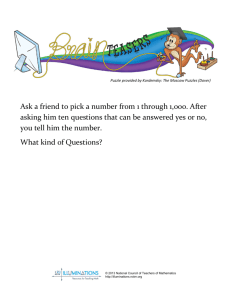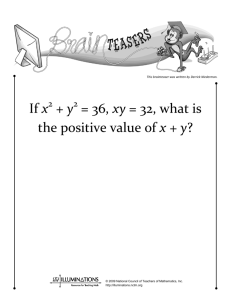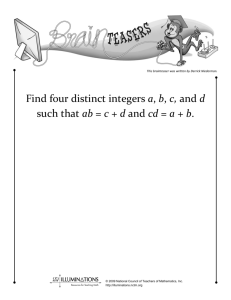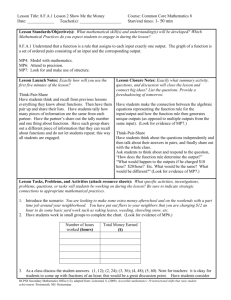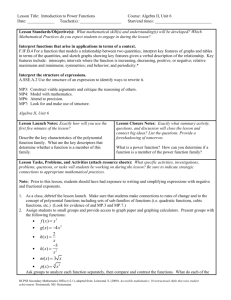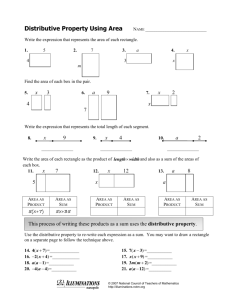F.BF.A.1 Lesson Building Functions
advertisement
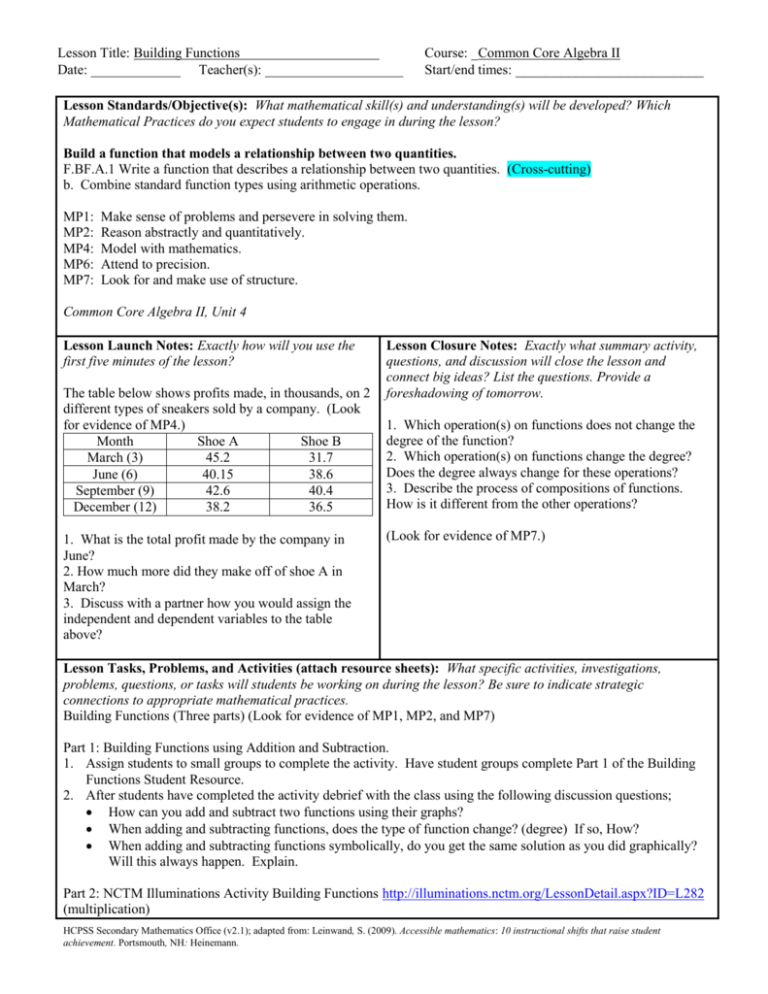
Lesson Title: Building Functions Date: _____________ Teacher(s): ____________________ Course: _Common Core Algebra II Start/end times: _________________________ Lesson Standards/Objective(s): What mathematical skill(s) and understanding(s) will be developed? Which Mathematical Practices do you expect students to engage in during the lesson? Build a function that models a relationship between two quantities. F.BF.A.1 Write a function that describes a relationship between two quantities. (Cross-cutting) b. Combine standard function types using arithmetic operations. MP1: MP2: MP4: MP6: MP7: Make sense of problems and persevere in solving them. Reason abstractly and quantitatively. Model with mathematics. Attend to precision. Look for and make use of structure. Common Core Algebra II, Unit 4 Lesson Launch Notes: Exactly how will you use the first five minutes of the lesson? The table below shows profits made, in thousands, on 2 different types of sneakers sold by a company. (Look for evidence of MP4.) Month Shoe A Shoe B March (3) 45.2 31.7 June (6) 40.15 38.6 September (9) 42.6 40.4 December (12) 38.2 36.5 1. What is the total profit made by the company in June? 2. How much more did they make off of shoe A in March? 3. Discuss with a partner how you would assign the independent and dependent variables to the table above? Lesson Closure Notes: Exactly what summary activity, questions, and discussion will close the lesson and connect big ideas? List the questions. Provide a foreshadowing of tomorrow. 1. Which operation(s) on functions does not change the degree of the function? 2. Which operation(s) on functions change the degree? Does the degree always change for these operations? 3. Describe the process of compositions of functions. How is it different from the other operations? (Look for evidence of MP7.) Lesson Tasks, Problems, and Activities (attach resource sheets): What specific activities, investigations, problems, questions, or tasks will students be working on during the lesson? Be sure to indicate strategic connections to appropriate mathematical practices. Building Functions (Three parts) (Look for evidence of MP1, MP2, and MP7) Part 1: Building Functions using Addition and Subtraction. 1. Assign students to small groups to complete the activity. Have student groups complete Part 1 of the Building Functions Student Resource. 2. After students have completed the activity debrief with the class using the following discussion questions; How can you add and subtract two functions using their graphs? When adding and subtracting functions, does the type of function change? (degree) If so, How? When adding and subtracting functions symbolically, do you get the same solution as you did graphically? Will this always happen. Explain. Part 2: NCTM Illuminations Activity Building Functions http://illuminations.nctm.org/LessonDetail.aspx?ID=L282 (multiplication) HCPSS Secondary Mathematics Office (v2.1); adapted from: Leinwand, S. (2009). Accessible mathematics: 10 instructional shifts that raise student achievement. Portsmouth, NH: Heinemann. Lesson Title: Building Functions Course: _Common Core Algebra II Date: _____________ Teacher(s): ____________________ Start/end times: _________________________ 1. Have students get back into their assigned groups to complete part 2. The students will be multiplying two linear functions to create a polynomial. (This three part activity has students building polynomials from linear functions.) 2. After students have completed the activity debrief with the class using the following discussion questions; How did the degree of the polynomial change when you multiplied the functions? What key feature of the polynomial do the linear factors give you? How can you use zeros of a polynomial to build linear factors? Part 3: Building Functions using Compositions. (Look for evidence of MP6.) 1. Have students complete this activity in their groups. (This activity introduces the idea of Compositions of Functions graphically.) 2. After students have completed the activity pose the following questions; How is composition of functions different from the other operations? Explain. Explain composition of functions on a graph. Be specific and use correct vocabulary. Evidence of Success: What exactly do I expect students to be able to do by the end of the lesson, and how will I measure student success? That is, deliberate consideration of what performances will convince you (and any outside observer) that your students have developed a deepened and conceptual understanding. Students should be able to complete operations on functions graphically by identifying points and using coordinates appropriately for the operation. They should also be able to graph the solutions. Students should also be able to apply addition, subtraction, and multiplication to functions represented symbolically. Notes and Nuances: Vocabulary, connections, anticipated misconceptions (and how they will be addressed), etc. The NCTM Illuminations activity may take 2 days to complete. Have students work through these activities in small groups. The operation of composition of functions is new to students. This activity just introduces the idea of compositions, and how to complete it graphically. Have students discuss that when they add/subtract, the degree (highest power from either function) does not change. For multiplication it does change, and for composition it may change. Resources: What materials or resources are essential for students to successfully complete the lesson tasks or activities? Homework: Exactly what follow-up homework tasks, problems, and/or exercises will be assigned upon the completion of the lesson? Building Functions Student Resource graphing calculator graph paper Homework to be determined by teacher. Lesson Reflections: How do you know that you were effective? What questions, connected to the lesson standards/objectives and evidence of success, will you use to reflect on the effectiveness of this lesson? Can students identify that the x-coordinate (independent variable) must match and the corresponding y-coordinate is what you add/subtract and multiply to complete the function operation? Can students use the output of one function as the input of another to complete a composition of functions? Can students complete the operations of functions to build a new function graphically? Howard County Public Schools Office of Secondary Mathematics Curricular Projects has licensed this product under a Creative Commons Attribution-NonCommercial-NoDerivs 3.0 Unported License. HCPSS Secondary Mathematics Office (v2.1); adapted from: Leinwand, S. (2009). Accessible mathematics: 10 instructional shifts that raise student achievement. Portsmouth, NH: Heinemann.
